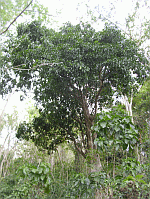

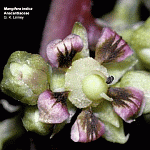
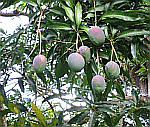
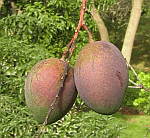
|
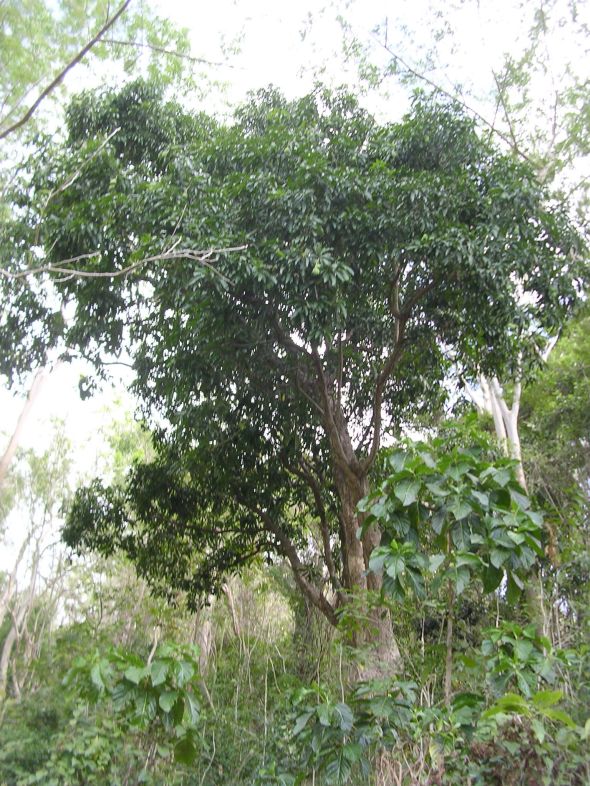
Davison Shillingford
Plant Family: Belongs surprisingly to the Anacardiaceae or Cashew family, notorious for embracing a number of highly poisonous plants such as the Poison Ivy of temperate regions (Rhus toxicodendron); family also includes Cashew or Pomme Noix (Anacardium occidentale), Hog Plum or Mombin (Spondias mombin) and Golden Apple (Spondias dulcis).
Description: One of the most delectable of fruits; several trees of different varieties (cultivars) can be seen in Gardens, for example, there are two mid-size specimens on hillside above Lower Garden Path, SE of current Agriculture Dept. building, but they are in poor condition, almost over-run by wild forest trees; typically, trees medium to large, up to 30 m high (100 ft) and 38 m in width (125 ft), quick-growing, with short, thick trunk bearing many branches forming dense, dome-shaped crown; old trees have small buttresses at base of stem; leaves lanceolate, persistent, shiny and somewhat brittle, 15-25 cm long(6-10 in), 2.5-5.0 cm wide (1-2 in), reddish when young, dark green later; flowers have male and female on same tree, are small, yellowish or reddish, with hundreds in showy, terminal, pyramidal, compound panicles, 8-38 cm long (3-15 in);
Fruit, depending on variety, roughly oval, kidney-shaped or round, fleshy, pendent drupe, with single flat, fibrous seed, varying in size, 5-25 cm long (2-10 in) and from a few ounces to about 2 kg (4.5 lbs), born singly or in pendulous groups on long stalk; when ripe, 2-2.5 months after flowering, fruit aromatic, usually green, greenish yellow or greenish pink; has thin skin, and thick, orange or peach-colored, sweet, very juicy, somewhat fibrous, slightly acid, aromatic pulp; there are numerous mango varieties with fruit varying in size, flesh quality and flavor; less attractive varieties have more fibrous flesh and a turpintiney flavor; dwarf varieties also exist, one being a slow-growing variant of the Julie cultivar; fruiting time about April-August; the prized variety in Dominica is Julie, other popular varieties include Longue, Lica, and Bitterskin;
Sap of tree and unripe fruit, especially peel, contains mangiferen, resinous acid, mangiferic acid, and the resinol, mangiferol; it can be severe irritant for some people, with typically delayed reaction, as with Poison Ivy; hypersensitive people may react with considerable swelling of eyelids, face, and other parts of body; condition referred to as "mango poisoning".
Natural Habitat: Thrives in drier tropics with a hot, dry season and deep, well-drained soil; for many varieties, propagation generally by seed, but viability short under natural conditions, less than one month; due to possibility of cross breeding, better varieties best propagated by grafting or layering to guarantee fruit quality and quicker bearing (4-5 years vs 6 or more years for seedlings).
Origin and Distribution: Indigenous to Tropical Asia, especially eastern India and Malay Peninsular; cultivated in all warm climates and variously in sub-tropics; varieties in Gardens include Julie, Chaewie and Bombay, survivors of the numerous varieties originally planted there.
Uses: Grown primarily for its delicious fruit, which usually eaten fresh; flesh also pulverized and made into various drinks, sherbert or icecream; unripe or half-ripe flesh used in chutneys and curries; leaves produce yellow dye, bark produces tannin, and wood used in shipbuilding; dwarf varieties also grown as fruit-bearing, specimen ornamentals; numerous medicinal uses, among which flowers, containing 15% tannin, used as astringents for diarrhea and dysentery; seed-embryo tea said to eradicate intestinal worms; bark contains mangiferine used in India as astringent for rheumatism and diphtheria; in Africa, latex was used to treat syphilis; in some Caribbean islands, leaf decoction taken as remedy for diarrhea, fever, chest complaints, diabetes, hypertension and other ills; extracts of unripe fruit, bark, stems and leaves have shown antibiotic activity.
Indigenous Legends: Considered the fruit par excellence of India, where it has been cultivated since ancient times; it was carried to the West Indies via Brazil, being first planted in Barbados about 1742 and Jamaica about 1782.
References:
Anon. Official Guide to the Botanic Gardens, Dominica. Kew Gardens, London, 1924?
Dorothy P. Storer. Familiar Trees and Cultivated Plants of Jamaica. Macmillan, London 1964.
J. B. Bourne, G.W. Lennox and S.A. Seddon. Fruits and Vegetables of the Caribbean. Macmillan, London 1988
H.F. Macmillan. Tropical Planting and Gardening. Macmillan, London 1956
Julia F. Morton. Fruits of Warm Climates. Publ: Julia F. Morton, Miami, FL 1987
Meet the Plants. US National Tropical Botanical Garden, Kalaheo, Hawaii 2004 (ntbg.org)
Robert A. DeFilipps. Useful Plants of the Commonwealth of Dominica, West Indies. Smithsonian Institution, Washington, D.C. 1998
Penelope N. Honeychurch. Caribbean Wild Plants and Their Uses. Macmillan, London, 1986
Arlington A. James. Cabrits Plants and Their Uses. Forestry and Wildlife Division, Ministry of Agriculture, Dominica 1999
|



